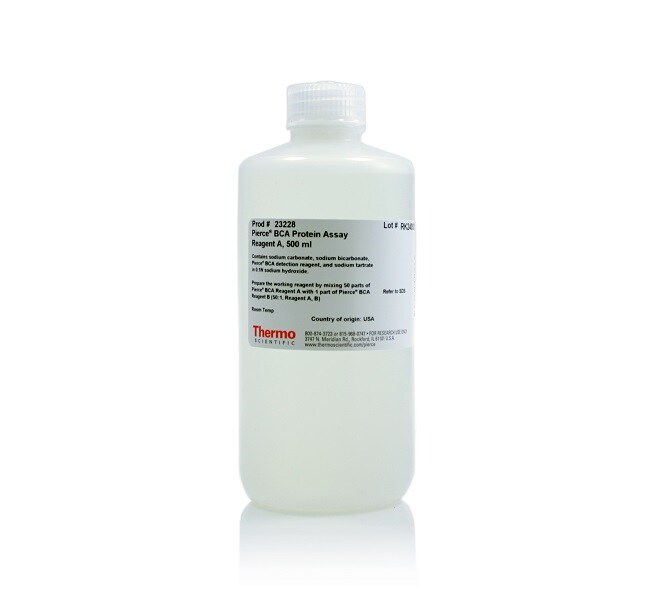
BCA Protein Assay Reagent A is a component of the Pierce BCA Protein Assay Kit, a two-component, high-precision, detergent-compatible assay that is used for total protein concentration determination compared to a protein standard. Pierce BCA reagents provide accurate determination of protein concentration with most sample types encountered in protein research. The Pierce BCA assay can be used to assess yields in whole cell lysates, affinity-column fractions, purified proteins samples, as well as to monitor protein contamination in industrial applications. Compared to most dye-binding methods, the BCA assay is affected much less by protein compositional differences, providing greater concentration accuracy.
Compare all available BCA protein assays ›
Features of the Pierce BCA Protein Assay Kit (Reagents A and B) include:
• Colorimetric—estimate visually or measure with a standard spectrophotometer or plate reader at 562 nm
• Uniformity—exhibits less protein-to-protein variation than dye-binding methods (Bradford)
• Compatibility—unaffected by typical concentrations of most ionic and non-ionic detergents
• Assay time—30-min incubation; much easier and four times faster than classical Lowry methods
• Assay range—linear working range for BSA of 20 to 2000 μg/mL
• Sensitivity—detect down to 5 μg/mL with the enhanced protocol
How the assay works
The BCA Protein Assay combines the well-known reduction of Cu2+ to Cu1+ by protein in an alkaline medium with the highly sensitive and selective colorimetric detection of the cuprous cation (Cu1+) by bicinchoninic acid (BCA). The first step is the chelation of copper with protein in an alkaline environment to form a light blue complex. In this reaction, known as the biuret reaction, peptides containing three or more amino acid residues form a colored chelate complex with cupric ions in an alkaline environment containing sodium potassium tartrate.
In the second step of the color development reaction, BCA reacts with the reduced (cuprous) cation that was formed in step one. The intense purple-colored reaction product results from the chelation of two molecules of BCA with one cuprous ion. The BCA/copper complex is water soluble and exhibits a strong linear absorbance at 562 nm with increasing protein concentrations. The complex is approximately 100 times more sensitive (lower limit of detection) than the pale blue color of the first reaction.
The reaction is strongly influenced by four amino acid residues (cysteine, cystine, tyrosine, and tryptophan) in the amino acid sequence of the protein. However, unlike Coomassie dye-binding methods, the universal peptide backbone also contributes to color formation, helping to minimize variability caused by protein compositional differences.
Related products
Pierce BCA Protein Assay Kit
Pierce BCA Protein Assay Reagent B
Pierce BCA Solid
| Code | Description |
|---|---|
| 23228 | Catalog Number: 23228 |
| 23222 | Catalog Number: 23222 |
| 23221 | Catalog Number: 23221 |
| 23223 | Catalog Number: 23223 |

